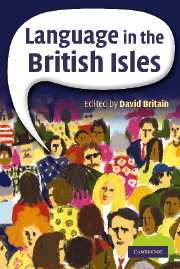Book contents
- Frontmatter
- Contents
- List of figures
- List of tables
- List of contributors
- Acknowledgements
- Map of the British Isles
- Introduction
- Part I English
- 1 The history of English
- 2 Standard and non-standard English
- 3 Phonological variation in England
- 4 Grammatical variation in England
- 5 Scottish English and Scots
- 6 Northern Irish English
- 7 Southern Irish English
- 8 English in Wales
- 9 English on the Isle of Man
- 10 English in the Channel Islands
- Part II The Celtic Languages
- Part III The Other Languages of the British Isles
- Part IV Applied Sociolinguistic Issues
- References
- Index
1 - The history of English
Published online by Cambridge University Press: 16 January 2010
- Frontmatter
- Contents
- List of figures
- List of tables
- List of contributors
- Acknowledgements
- Map of the British Isles
- Introduction
- Part I English
- 1 The history of English
- 2 Standard and non-standard English
- 3 Phonological variation in England
- 4 Grammatical variation in England
- 5 Scottish English and Scots
- 6 Northern Irish English
- 7 Southern Irish English
- 8 English in Wales
- 9 English on the Isle of Man
- 10 English in the Channel Islands
- Part II The Celtic Languages
- Part III The Other Languages of the British Isles
- Part IV Applied Sociolinguistic Issues
- References
- Index
Summary
Introduction
Typological change
During the past nine centuries, English has undergone more dramatic changes than any other major European language in the same period. Old English was moderately highly inflected for case, number, gender, tense, mood and other grammatical categories. Present English, however, has a vastly simplified inflectional morphology with total loss of inflections in, for example, adjectives and the definite article, and very considerable inflectional losses in other word classes. There have also been many phonological changes, and the lexicon has been altered from mainly Germanic to a mixed Germanic–Romance type. In syntax, a mixed SVO–SOV word order has become mainly SVO, and there have been great changes in the tense, mood and aspect systems of the verb. These changes, taken together, amount to a typological change from mainly synthetic to mainly analytic, and to considerable modification of the Germanic character of English. As a result, OE (Anglo-Saxon) is not immediately accessible to the modern native reader and can be acquired only through intensive study – as though it were a foreign language.
Origins and geographical spread
English is descended from the Germanic branch of the Indo-European family of languages. Within this it is assigned to the West Germanic group, and its nearest relative is Frisian (still spoken by a few thousand people on the coasts and islands of northern Germany and the Netherlands), with which OE shared some common developments (for example, raising of Germanic (Gmc) /a/ to /æ/: ‘Anglo-Frisian brightening’).
- Type
- Chapter
- Information
- Language in the British Isles , pp. 9 - 33Publisher: Cambridge University PressPrint publication year: 2007
- 3
- Cited by

